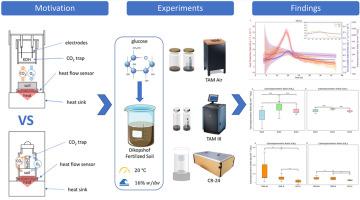土壤微生物代谢:从热,二氧化碳排放和同位素分析的见解使用新的大热量呼吸计
IF 10.3
1区 农林科学
Q1 SOIL SCIENCE
引用次数: 0
摘要
土壤作为最大的陆地碳汇,在全球碳循环中起着举足轻重的作用。土壤微生物是土壤中所有生化过程的基础,确保其肥力并支持平衡的生态系统。通过它们的代谢活动,这些微生物驱动能量和物质流动,使有机物矿化并释放热量和二氧化碳,这些可以通过量热肺法测量。传统量热计的一个关键限制在于它们无法将高样品通量与足够大的样品容量结合起来,同时在测量过程中避免氧气限制。为了克服这些缺点,我们开发了一种用于土壤分析的多通道大热量呼吸计(CR-12)。为了证明它的应用,用12C(未标记)和13C(标记)葡萄糖修饰的农业土壤(Dikopshof, Luvisol)进行了四次实验。与商用等温微量热量计的比较证实了CR-12对土壤系统的适用性,提供了可靠的热量、二氧化碳测量和与已知碳水化合物有氧代谢范围一致的热肺比。为了进一步研究碳进入土壤有机质(SOM)的情况,采用热重-差示扫描量热-四极杆质谱法(TG-DSC-QMS)对时间序列土壤样品进行质谱分析(12C-CO2为m/z 44, 13C-CO2为m/z 45)。热量肺量计和质谱数据的整合表明,结合这些互补的技术,可以提供有关微生物碳和SOM内能量周转命运的更详细信息。本文章由计算机程序翻译,如有差异,请以英文原文为准。

Soil Microbial Metabolism: Insights from Heat, CO2 emission and Isotope Analysis Using a Novel Macrocalorespirometer
Soil, as the largest terrestrial carbon sink, plays a pivotal role in the global carbon cycle. Soil microorganisms are fundamental to all biochemical processes in soil, ensuring its fertility and supporting a balanced ecosystem. Through their metabolic activities, these microorganisms drive energy and matter flows, mineralizing organic matter and releasing heat and CO2, which can be measured via calorespirometry. A key limitation of conventional calorimeters lies in their inability to combine high sample throughput with sufficiently large sample sizes while avoiding oxygen limitation during measurement. In order to overcome these weaknesses, we have developed a multi-channel macrocalorespirometer (CR-12) for soil analysis. To demonstrate its application, agricultural soil (Dikopshof, Luvisol) amended with 12C (unlabeled) and 13C (labeled) glucose was used in four experiments. Comparisons with commercial isothermal microcalorimeters confirmed the suitability of CR-12 for soil systems, providing reliable heat, CO2 measurements and calorespirometric ratios that align with known ranges for the aerobic turnover of carbohydrates. To further investigate the incorporation of carbon into the soil organic matter (SOM), a time series of soil samples amended with 13C-labeled glucose was subjected to mass spectrometric analysis (m/z 44 for 12C-CO2; m/z 45 for 13C-CO2) using thermogravimetry-differential scanning calorimetry-quadrupole mass spectrometry (TG-DSC-QMS). The integration of calorespirometric and mass spectrometric data demonstrated that combining these complementary techniques provides more detailed information on the fate of microbial carbon and energy turnover within SOM.
求助全文
通过发布文献求助,成功后即可免费获取论文全文。
去求助
来源期刊

Soil Biology & Biochemistry
农林科学-土壤科学
CiteScore
16.90
自引率
9.30%
发文量
312
审稿时长
49 days
期刊介绍:
Soil Biology & Biochemistry publishes original research articles of international significance focusing on biological processes in soil and their applications to soil and environmental quality. Major topics include the ecology and biochemical processes of soil organisms, their effects on the environment, and interactions with plants. The journal also welcomes state-of-the-art reviews and discussions on contemporary research in soil biology and biochemistry.
 求助内容:
求助内容: 应助结果提醒方式:
应助结果提醒方式:


